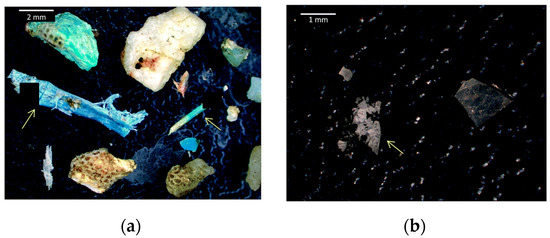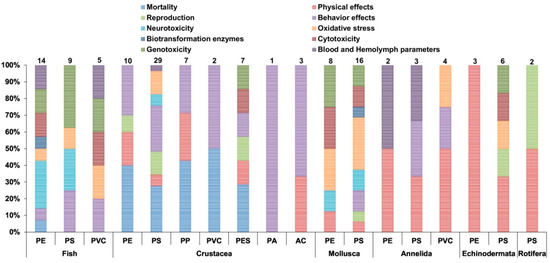Plastics are widely used due to their excellent properties, inexpensiveness and versatility leading to an exponential consumption growth during the last decades. However, most plastic does not biodegrade in any meaningful sense; it can exist for hundreds of years. Only a small percentage of plastic waste is recycled, the rest being dumped in landfills, incinerated or simply not collected.
Microplastics can be generally divided in two big families: primary microplastics and secondary microplastics [2,10–12]. Plastics with microscopic size, ca. 2–5 mm in diameter, are defined as primary microplastics [13–15]. Secondary microplastics enclose tiny plastic fragments derived from the breakdown of larger plastic debris, both at sea and on land. Waste-water treatment plants can only minimize the problem by trapping plastic particles of larger size and some smaller ones remain within oxidation ponds or sewage sludge, but a large amount of microplastics still contaminate water streams and marine systems.
- Microplastics
- ecosystems
- wastewater
Note:All the information in this draft can be edited by authors. And the entry will be online only after authors edit and submit it.
1. Introduction
Intimately related, microplastics are defined as plastic particles with less than 5 mm in length that are either formed by the fragmentation of larger plastics or are intentionally produced and added, for instance, into cosmetics and other personal care products [2,8,9]. Over time, a combination of physical, biological and chemical processes can reduce the structural integrity of plastic debris, resulting in their fragmentation [16,17]. As can be seen in Figure 1, this comprises a very heterogeneous assemblage of pieces that vary in size, shape, colour, specific density, chemical composition and other characteristics which, as it will be discussed later, should be considered during the development of appropriate methods for their extraction and characterization [18,19].

Figure 1. Images of Pacific Ocean trawl microplastic particles, a) primary and b) secondary microplastics, some with adhered crustaceans, mineral crusts, or radiolarians (taken from reference [19] with permission of the Royal Society of Chemistry).
2. Plastics, Microplastics and their Impact in the Ecosystems
Despite the extensive use of plastics, microplastics have recently become a central discussion theme around the world, not because of their societal benefits but mainly due to their potential nefarious impact on different ecosystems. Increasing evidences tend to show that microplastics have a negative impact, particularly on the marine environment and biota, leading to increasing environmental awareness [1,27].
Plastic pollution (and, consequently, the amount of microplastics) in the oceans is significantly growing. Normally, high-density particles sink and accumulate in the sediment, while low-density particles float at the sea surface. However, due to their small dimensions, microplastics are easily available for uptake to a wide range of marine organisms [27,28]. This reduction in size not only impairs the cleanliness of the waters, but also causes some marine animals death due to ingestion. Due to their hydrophobic properties, microplastics can also adsorb and enter the marine food-webs [23,24]. In Figures 2 and 3, examples of real effects of plastic materials in marine organisms are illustrated. A comprehensive report presented by Murray identifies some impacted species, the materials involved, as well as location and source [23]. The identified species include turtles; penguins; albatrosses; petrels and shearwaters; shorebirds; skuas; gulls and auks; coastal birds other than seabirds such as baleen whales, toothed whales and dolphins; earless or true seals; sea lions and fur seals; manatees and dugong; sea otters; fish; and crustaceans [23]. The report from the “Task Group 10” from the European Commission about marine litter has reached similar conclusions [23,29,30].

Figure 2. Examples of animals that ingested microplastics: (a) southern black-backed gull, Larus dominicanus caught and hooked in nylon filament fishing line; (b) a New Zealand fur seal trapped in discarded netting and (c) Ghost fishing-derelict fishing gear dredged from >100 m on the Otago shelf (taken from reference [23] with permission of the Royal Society).

Figure 3. Examples of ingestion: (a) Laysan Albatross; (b) plastic from the stomach of a young Minke whale that had been washed ashore dead in France and (c) stranded sea turtle disgorging an inflated plastic bag. (taken from reference [23] with permission of the Royal Society).
Many properties that humankind find so desirable in plastic materials are also the same responsible for the plethora of problems they are globally creating, particularly in marine environments. Recently, Barboza et al. (2020) reported that any marine organisms, such as crustaceans, molluscs and fish when in exposure to microplastics may induce physical and chemical toxicity, including genotoxicity, oxidative stress, changes in behaviour, reproductive impairment, mortality, population growth rate decrease, transgenerational effects, among several others [31]. The authors also estimate that microplastics are potentially taken in by human adults from fish consumption. Another study presented by de Sá, et al. (2018) demonstrated the different ecotoxicological effects per polymer/plastic family (Figure 4). Studies were defined according to the type of MPs, groups of organisms and effects. It is clear the potential effects of MPs on aquatic biota and the problems caused every day in a large number of organisms when exposed to these particles. This exposure may cause a variety of effects and threaten individuals of many different species, in the ecosystems they live in and, ultimately, humans [32].

Figure 4. Ecotoxicological effects of microplastics on the different groups of organisms. Each bar has the total number of studies on it. [32].
Although plastics are generically regarded as inert materials, with low/negligible chemical reactivity [33], there has been questions about whether its dissemination in the body and organs may not be the cause of different health issues [34]. Additionally, depending on the source (e.g., ship hull paints, fibres, rubber, polyethylenes, polypropylenes, or others), plastic may also contain different types of chemical additives which, due to their nature, may also be absorbed, contributing to unexpected adverse health problems [35]. For instance, it has been observed that the absorption of microplastics and nanoplastics by humans can lead to a wide range of organism’s obstruction, inflammation and accumulation in organs after translocation [36]. As stated by Pete Myers, founder and chief scientist of the nonprofit Environmental Health Sciences, the ingestion of microplastics can expose humans to different chemicals found in their compositions known to induce harmful effect and connected to different health issues, such as reproductive harm and obesity, organ problems and developmental delays in children. These microplastics could potentially leach their constituents, adsorbed contaminants and pathogenic organisms. On the other hand, reduction in photosynthesis of plants and effects on the feeding activity of zooplankton and marine animals (adverse effects to gill, stomach and alterations in histology) have also been argued to occur after microplastic intake [29,30]. These and other effects are well described and summarised in the recent review by Prata et al. [12]. In a recent SAPEA report [37], although the authors recognize limitations in the measurement methods currently available, they state that the concentration levels measured in many real-world locations are well below the concentration threshold observed to induce harmful effect on living creatures. Moreover, the potential nanoplastics effects are even more obscure due to the problems associated to their identification and evaluation. It is important to note that microplastic toxicity greatly depends on its concentration but other parameters, such as particle features, adsorbed contaminant agents, tissues involved, individual susceptibility, etc, may play an important role in their final toxic effect and this still remains to be properly addressed and clarified by the scientific community. Due to their capacity to move between different tissues of plants and animals, along the food chain, and strong indications of associated health issues, their “inert” features must be seriously reconsidered. It is clear that the studies regarding the microplastic toxicity, particularly to humans, are still very scarce, and thus, it definitely requires future research. The fact that there are no population studies on human health effects, has been motive of concern by a group of chief scientific advisors to the European Commission [38]. This independent expert group has recommended the EU to not only identify the most polluting activities with current or new legal actions but also establish a global scientific platform to promote microplastic research. These actions should be politically and socio-economically feasible and hopefully contribute to clarify the potential threat of microplastics and guide the future action policies of EU.
Plastic litter with a terrestrial source contributes to 80% of the plastics found in marine litter. Such plastics include primary microplastics used in cosmetics and air-blasting, improperly disposed ‘‘user’’ plastics and plastic leachates from refuse sites [1]. With approximately half the world’s population living within 100 kilometres of the coast, these types of plastic are highly prone to enter the marine environment via rivers and wastewater systems, or by being blown off-shore [6]. These microplastics can also enter waterways via domestic or industrial drainage systems [39]; whilst wastewater treatment plants trap macroplastics and some small plastic debris within oxidation ponds or sewage sludge, a large amount of microplastics passes through the filtration systems [40,41]. Plastics that enter river systems, either directly or within wastewater effluent or in refuse site leachates, will then be transported out to sea. Numerous studies have clearly shown how the high unidirectional flow of freshwater systems drives the movement of plastic debris into the oceans [1,42,43].
Besides the migration of microplastics from terrestrial sources, changes in marine equipments, such as transportation and fishing ships, contribute to the increase of plastic litter on the sea. For example, prior to the 1950s, all rope and cordage used in marine activities, including fisheries, were made of natural fibres-typically Indian or Manila hemp and cotton. These systems were often strengthened with a coating of tar or strips of worn canvas. Once these materials lost their resilience in continuous usage or if they were lost /discarded at sea, they tended to quickly degrade. However, for durability and performance reasons, these natural fibres have been replaced by nylon and other synthetic materials that are generally buoyant and far more endurable [1].
In order to face the plastic problem, research on bioplastics has been growing enormously. Environmentally friendly alternatives to traditional plastics are synthesized from biomass and renewable resources, such as Poly(lactic acid) (PLA) and Polyhydroxyalkanoate (PHA), or from fossil fuel including aliphatic plastics, such as Polybutylene succinate (PBS), which can also be used as a substrate to microorganisms [20] . With the production of bioplastics, it is also possible to reduce the CO2 emission, which helps minimize the greenhouse effect. Thus, the development of biodegradable plastics is often seen as a viable alternative for traditional plastics. However, they can also be a source of microplastics [44]. Biodegradable plastic materials are typically composed of synthetic polymers combined with biodegradable vegetable polymers, such as starch or vegetable oils, or with specialized chemicals (e.g., TDPA™) designed to enhance the kinetics of degradation [39]. If properly disposed, these systems are expected to decompose in industrial composting plants using appropriate heat, humidity and ventilation conditions. However, this decomposition is only partial; while components such as starch decompose, the synthetic polymers will be left behind untouched [21]. Moreover, in the relatively cold marine environment and in the absence of terrestrial microbes, decomposition rates of even degradable bioplastic components will be significantly prolonged, increasing the likelihood of plastic fouling and, subsequently, reducing the UV permeation, essential for the degradation process [45]. At the end, when decomposition finally occurs, microplastics are released into the marine environment, contributing to sea water pollution. Indeed, bioplastics and biodegradable systems are quite appealing but, at the moment, are far from solving the problem.
This entry is adapted from the peer-reviewed paper 10.3390/molecules25173954
